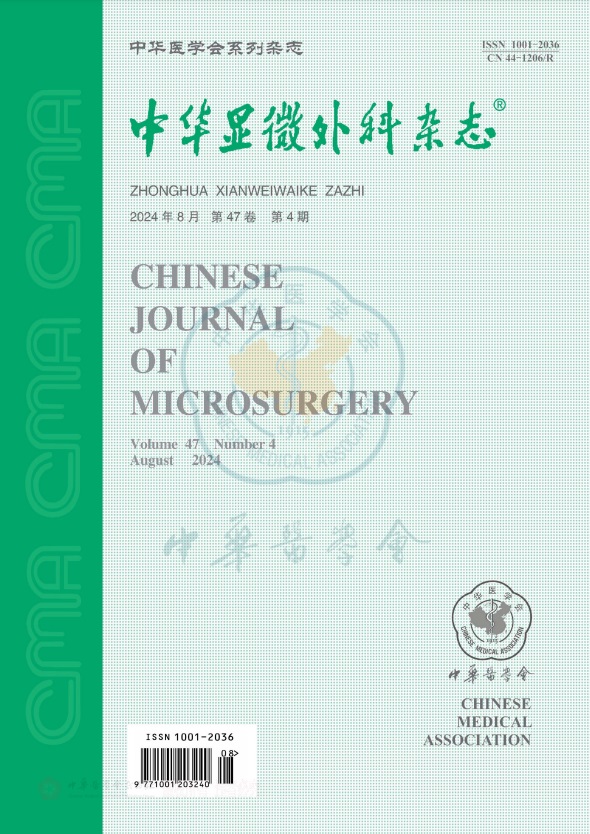Application of double-leaf perforator free flap of posterolateral calf peroneal artery in repairing facial through-and-through defect after oral cancer oblation
引用次数: 0
Abstract
Objective To evaluate the effect of double-leaf perforator free flap pedicled with posterolateral calf peroneal artery on repairing facial through-and-through defect after oral cancer oblation. Methods Nine patients with facial through-and-through defects after oblation of oral and maxillofacial malignancies, including 4 cases of buccal mucosa carcinoma, 2 cases of maxilla osteosarcoma, 1 case of carcinoma of the maxillary sinus and 2 cases of parotid duct carcinoma, were recruited from May, 2016 to May, 2018. The flap was used to repair the facial defect of recruited patients. The area of the bigger leaf of bilobed perforator flap was 7.0 cm×8.0 cm-6.0 cm×7.0 cm and the small leaf was 4.5 cm×4.5 cm-4.0 cm×4.0 cm, respectively. The intraoral and facial defects needed to be reconstructed contained the oral mucosal of the upper palate, the skin, subcutaneous tissue and mucosa of the cheek. The radiotherapy was performed 1.0-1.5 months after the operation. The prognosis including appearance, mouth opening, and the functions of deglutition, and language were assessed. Results Through 3-18 months outpatient followed-up, all 9 cases of transplanted flaps survived well and the incisions of the donor and recipient areas healed by first intention. The patients were satisfied with the facial appearance, mouth opening, and the functions of deglutition and language at the 6 months follow-up. The radiotherapy had no damage on the survival of the bilobed perforator flap. There was no recurrence or metastasis in follow-up. Conclusion The double-leaf perforator free flap pedicled with posterolateral calf peroneal artery is an ideal free tissue for repairing the facial perforating defect after oral cancer oblation because of its constant blood vessel, abundant tissues, flexible design and operating methods. Key words: Oral cancer; Through-and-through defect; Double-leaf perforator free flap; Peroneal artery; Repair小腿腓后外侧动脉游离双叶穿支皮瓣在口腔癌切除后面部贯通缺损修复中的应用
目的探讨以腓骨后外侧动脉为蒂的双叶穿支游离皮瓣修复口腔癌切除后面部贯通缺损的效果。方法选取2016年5月~ 2018年5月9例口腔颌面部恶性肿瘤切除后面部穿透性缺损患者,包括4例口腔黏膜癌、2例上颌骨肉瘤、1例上颌窦癌和2例腮腺导管癌。皮瓣被用于修复招募患者的面部缺损。双叶穿支瓣大叶面积7.0 cm×8.0 cm ~ 6.0 cm×7.0 cm,小叶面积4.5 cm×4.5 cm ~ 4.0 cm×4.0 cm。需要重建的口内及面部缺损包括上腭口腔黏膜、皮肤、皮下组织及颊部黏膜。术后1.0 ~ 1.5个月行放疗。评估预后,包括外观、开口、吞咽功能和语言。结果经门诊随访3 ~ 18个月,9例皮瓣移植成活良好,供、受区切口一期愈合。随访6个月,患者面部外观、开口、吞咽和语言功能均满意。放疗对双叶穿支皮瓣存活无损害。随访无复发、转移。结论以腓骨后外侧动脉为蒂的双叶穿支游离皮瓣血管通畅、组织丰富、设计灵活、操作方法灵活,是修复口腔癌术后面部穿支缺损的理想游离组织。关键词:口腔癌;地地道道的缺陷;双叶穿孔自由瓣;腓动脉;修复
本文章由计算机程序翻译,如有差异,请以英文原文为准。
求助全文
约1分钟内获得全文
求助全文
来源期刊
CiteScore
0.50
自引率
0.00%
发文量
6448
期刊介绍:
Chinese Journal of Microsurgery was established in 1978, the predecessor of which is Microsurgery. Chinese Journal of Microsurgery is now indexed by WPRIM, CNKI, Wanfang Data, CSCD, etc. The impact factor of the journal is 1.731 in 2017, ranking the third among all journal of comprehensive surgery.
The journal covers clinical and basic studies in field of microsurgery. Articles with clinical interest and implications will be given preference.

 求助内容:
求助内容: 应助结果提醒方式:
应助结果提醒方式:


